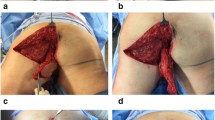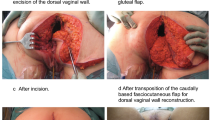Abstract
Vaginal reconstruction after pelvic exenteration not only affords significant psychological benefit, it also decreases the morbidity and mortality associated with pelvic exenteration. In irradiated patients filling the surgical defect with healthy, well-vascularized tissue, such as omental flaps, colonic advancements, and myocutaneous flaps, has been shown to decrease the incidence of fistulas, bowel obstructions, infections, and hemorrhage. A novel use of the gluteal perforator-based flap is described in the unique circumstance of posterior pelvic exenteration with sacrectomy.
Similar content being viewed by others
References
Kroll SS, Rosenfield L. Perforator-based flaps for low posterior midline defects. Plast Reconstr Surg 1988;81:561–6.
Koshima I, Moriguchi T, Soeda S, Kawata S, Ohta S, Ikeda A. The gluteal perforator-based flap for repair of sacral pressure sores. Plast Reconstr Surg 1993;91:678–83.
Masakazu A, Okiharu M, Yuuzaburou N, Asagoe K. Perforator-based flap for coverage of lumbosacral defects. Plast Reconstr Surg 1998;101:987–91.
Martello JY, Vasconez HC. Vulvar and vaginal reconstruction after surgical treatment for gynecologic cancer. Clin Plast Surg 1995;22:129–40.
Kusiak JF, Rosenblum NG. Neovaginal reconstruction after exenteration using an omental flap and splitthickness skin graft. Plast Reconstr Surg 1996;97:775–83.
Cocke WM, Bolasny BL, Sawyers JL. Vaginal reconstruction following extended abdominoperineal resection. Plast Reconstr Surg 1970;46:372–4.
Soper JT, Berchuck A, Creasman WT, Clarke-Pearson DL. Pelvic exenteration: factors associated with major surgical morbidity. Gynecol Oncol 1989;35:93–8.
McCraw JB, Massey FM, Shanklin KD, Horton CE. Vaginal reconstruction with gracilis myocutaneous flaps. Plast Reconstr Surg 1976;58:176–83.
Soper JT, Rodriguez G, Berchuck A, Clarke-Pearson DL. Long and short gracilis myocutaneous flaps for vulvovaginal reconstruction after radical pelvic surgery: comparison of flap-specific complications. Gynecol Oncol 1995;56:271–5.
Tobin GR, Day TG. Vaginal and pelvic reconstruction with distally based rectus abdominis myocutaneous flaps. Plast Reconstr Surg 1988;81:62–70.
Smith HO, Genesen MC, Runowicz CD, Goldberg GL. The rectus abdominis myocutaneous flap. Cancer 1998;83:510–20.
Author information
Authors and Affiliations
About this article
Cite this article
Judge, B.A., García-Aguilar, J. & Landis, G.H. Modification of the gluteal perforator-based flap for reconstruction of the posterior vagina. Dis Colon Rectum 43, 1020–1022 (2000). https://doi.org/10.1007/BF02237372
Issue Date:
DOI: https://doi.org/10.1007/BF02237372




